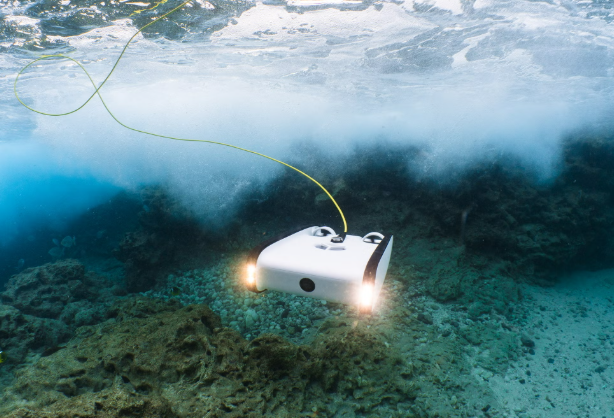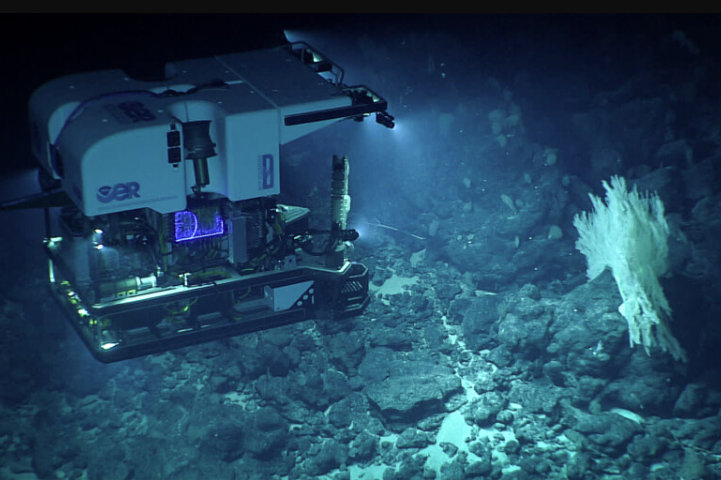
For centuries, the vast depths of our oceans have remained Earth's final frontier, more alien and inaccessible than the lunar surface. Imagine deploying intelligent machines capable of exploring crushing depths, mapping uncharted trenches, repairing vital infrastructure miles underwater, or uncovering sunken history – all autonomously. This is not science fiction; it's the cutting-edge reality powered by Underwater AI Robots. This transformative technology is revolutionizing ocean exploration, industry, and science, turning the once-impenetrable deep blue into a realm of exciting possibility. Discover how these robotic marvels operate, the groundbreaking tasks they perform, and why they represent a pivotal leap in understanding and utilizing our planet's most vital resource.
What Exactly Are Underwater AI Robots?
Underwater AI Robots, also known as Autonomous Underwater Vehicles (AUVs) or Remotely Operated Vehicles (ROVs) enhanced with artificial intelligence, are sophisticated machines designed to operate independently or semi-independently in aquatic environments. Unlike basic remotely controlled subs, these robots integrate advanced sensors (sonar, cameras, chemical detectors), propulsion systems for precise maneuverability, and crucially, onboard artificial intelligence processors. This AI enables them to process vast amounts of sensory data in real-time, make critical decisions about navigation, obstacle avoidance, and mission execution without constant human direction. They can be gliders for long-duration surveys, propelled AUVs for high-resolution mapping, or work-class ROVs performing complex interventions, all empowered by intelligence beneath the waves.
The Brains Beneath the Waves: How Underwater AI Robots Actually Work
The core magic of Underwater AI Robots lies in the seamless integration of hardware and advanced software. Navigating the complex, feature-poor underwater terrain requires sophisticated AI algorithms. Simultaneous Localization and Mapping (SLAM) allows the robot to build a map of its unknown surroundings while simultaneously tracking its own position within that map – a task exponentially harder underwater than on land due to GPS limitations. Object recognition AI analyzes sonar pings and camera feeds (often enhanced by low-light capabilities) to identify obstacles, marine life, or mission-specific targets like pipelines or archaeological artifacts. Pathfinding algorithms then chart the most efficient and obstacle-free course based on the mission parameters. Communication, however, remains a challenge; while acoustic modems transmit data, bandwidth is low, making onboard AI decision-making essential for tasks requiring real-time responsiveness, from avoiding a fragile coral reef to adjusting a manipulator arm based on visual feedback.
Beyond Exploration: The Diverse Missions of Underwater AI Robots
The applications for Underwater AI Robots extend far beyond simple mapping. They are vital tools across numerous sectors. In offshore energy, these robots conduct detailed inspections of oil and gas infrastructure (pipelines, rigs), often identifying micro-corrosion or structural weaknesses invisible to human divers. Their precision enables tasks like Underwater Welding and maintenance in hazardous environments previously requiring saturation diving. Oceanographers deploy fleets of AI-powered gliders and AUVs for months-long missions, collecting unprecedented data on temperature, salinity, currents, and marine life distribution, feeding crucial models for climate change prediction. Archaeologists leverage high-resolution sonar and AI-enhanced photogrammetry from these robots to locate and meticulously document ancient shipwrecks without disturbing the sites. Furthermore, Underwater AI Robots are becoming indispensable for critical infrastructure, inspecting and repairing submarine telecommunications cables – the backbone of global internet traffic. In search and rescue operations, they can scan large seabed areas efficiently where divers cannot go.
Cutting-Edge Innovations: Where Underwater AI Robots are Headed
The field of Underwater AI Robots is advancing at a phenomenal pace, driven by AI breakthroughs and material science. Swarm intelligence is a major frontier. Imagine coordinating dozens, even hundreds, of relatively small AI robots working together like a school of fish. They could blanket enormous areas of the seabed for rapid mapping, environmental monitoring, or search operations, sharing data acoustically to build a collective situational awareness far greater than any single unit's capability. Biomimetic designs are another exciting trend. Engineers are creating robots that mimic the forms and movements of marine animals like manta rays, squid, or eels. These bio-inspired shapes offer potentially superior energy efficiency, quieter operation (less disturbance to marine life), and enhanced maneuverability in tight spaces like coral reefs or wrecks. Edge AI processing is also evolving rapidly. Faster, more energy-efficient onboard chips allow robots to run increasingly complex AI models directly on the vehicle, enabling faster decision-making and autonomy during complex inspection or manipulation tasks without waiting for distant operator input. The integration of Multi-Beam Imaging Sonar (MBIS) with real-time AI object detection allows for stunningly detailed 3D reconstructions of underwater structures almost instantly. Advancements in battery technology and energy harvesting (like using wave motion or ocean thermal gradients) are also extending operational endurance significantly.
The Tangible Benefits: Why Underwater AI Robots Matter
The impact of deploying Underwater AI Robots versus traditional methods is profound. Safety is paramount. Robots undertake dangerous missions in extreme depths, contaminated waters, or under hazardous structures, completely eliminating the risk to human divers. Their endurance and lack of decompression requirements mean missions can last days, weeks, or even months (in the case of gliders), vastly increasing data collection periods and operational windows. Cost-efficiency emerges over time; while initial investment can be high, the reduced need for large surface support vessels, extensive dive teams, and associated logistics leads to significant long-term savings, especially for routine inspections or large-scale surveys. The precision offered by AI navigation and data collection far exceeds manual methods, leading to higher quality data for scientific analysis or engineering assessment. They also offer non-invasive exploration capabilities vital for delicate archaeological sites or fragile marine ecosystems. This combination of safety, endurance, efficiency, and precision makes AI robotics the future of subsea operations. Unveiling the Ocean's Secrets has never been more efficient or less intrusive.
Navigating the Deep: Challenges & Ethical Considerations
Despite their promise, significant hurdles remain. The immense hydrostatic pressure at depth demands exceptionally robust and expensive pressure housings. Sensor limitations persist; acoustic sensors have limited range and resolution compared to visual light above water, while optical clarity underwater is often poor. Power constraints remain a key bottleneck for propulsion and computation, limiting speed and mission duration for power-intensive tasks. Environmental complexities like strong currents, turbidity, and biofouling (marine growth on surfaces) constantly challenge sensors and operations. Furthermore, the burgeoning use of Underwater AI Robots raises ethical questions. Privacy concerns arise regarding their potential to operate near critical undersea infrastructure or in sensitive maritime zones. Regulations governing autonomy levels, liability in case of accidents, and preventing interference with maritime activities are still evolving. Crucially, responsible use mandates minimizing disturbance to marine ecosystems – ensuring quiet propulsion and careful navigation to avoid damaging habitats or stressing marine life. Transparency in deployment intentions is essential for global cooperation.
Frequently Asked Questions
Can Underwater AI Robots completely replace human divers?
While AI robots excel in deep, dangerous, or prolonged tasks, human divers remain essential for highly complex manipulations requiring dexterity, nuanced problem-solving in unpredictable situations, and tasks where human judgment and intuition are irreplaceable. Robots and divers often work collaboratively.
How deep can Underwater AI Robots operate?
This varies greatly by design. Standard commercial or research robots often operate down to 3,000-6,000 meters. However, specialized deep-sea AUVs, like the famous Nereus (before loss) or newer models developed for exploring trenches, can reach the ocean's deepest points beyond 10,000 meters (Challenger Deep).
What kind of sensors do Underwater AI Robots carry?
Common sensors include multibeam and side-scan sonars for mapping and imaging, optical cameras (HD, 4K, low-light), CTD sensors (Conductivity, Temperature, Depth), current profilers, chemical sensors (pH, dissolved oxygen, methane), magnetometers for detecting metal objects, and sometimes manipulator arms with force/torque sensors for interaction.
How long can Underwater AI Robots stay submerged?
Mission duration varies drastically. Torpedo-style AUVs might run 8-48 hours depending on speed and sensors. Gliders can stay submerged for months, slowly traversing oceans while surfacing periodically to transmit data and get GPS fixes. Work-class ROVs on tethers are limited by cable length and ship support, typically operating for days at a time.
Conclusion: Diving into a Robotic Future
The era of Underwater AI Robots is not merely arriving; it's rapidly evolving into the new standard for interacting with our planet's final frontier. These sophisticated machines, blending robust engineering with increasingly powerful artificial intelligence, are unlocking the oceans in ways previously unimaginable. They enhance our scientific understanding, safeguard critical infrastructure, bolster offshore industries, protect fragile ecosystems through non-invasive study, and offer glimpses into submerged human history. As challenges around power, sensing, and autonomy are steadily overcome, we stand on the precipice of even greater discoveries. The continued responsible development and deployment of Underwater AI Robots promise not only deeper insights into the blue heart of our planet but also sustainable solutions for managing its resources and navigating the profound impacts of climate change on our marine environments. The future beneath the waves is intelligent, robotic, and full of potential.







